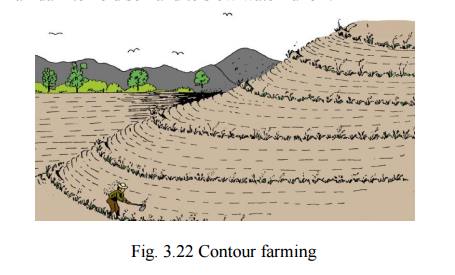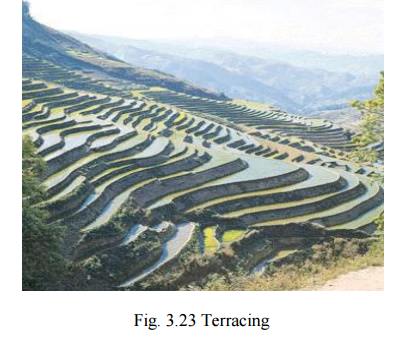Chapter: Environmental Science and Engineering
Land Resources
LAND RESOURCES
It
provides food, fibre, wood, medicine and other biological materials
Soil is
the mixture of inorganic materials (rocks and minerals) and organic materials
(dead animals and plants).
Top soil
is classified as renewable resources.
Uses of land resources
Land
provide, food, wood, minerals, etc., for us
Land
nurtures the plants and animals that provide our food and shelter.
Land is
used as watershed or reservoir
Land acts
as a dust bin for most of the wastes, created by the modern society.
Land is
used for construction of buildings, industries.
1 LAND DEGRADATION
Process
of degradation of soil or loss of fertility of the soil.
Harmful effects of land
degradation
The soil
texture and soil structure are deteriorated
Loss of
soil fertility, due to loss of invaluable nutrients
Increase
in water logging, salinity, and alkalinity and acidity problems.
Loss of
economic social and biodiversity.
Causes of
land degradation 3. Population
Land
resources degraded by over population &over exploitation.
2. Urbanization
Urbanization
leads to deforestation, reduces the land
3. Fertilizers and pesticides
Increased
applications of fertilizers and pesticides leads to pollution of land and water
and soil degradation.
4. Damage of top soil
Increase
in food production generally leads to damage to top soil through nutrient
depletion.
5. Water-logging
Soil
erosion, salination and contamination of the soil with industrial wastes all
cause land degradation.
6. Soil erosion
Soil
erosion is the process of removal of superficial layer of the soil from one
place to another.
Harmful effects of soil erosion
Soil
fertility is lost because of loss of top soil layer.
Loss of
its ability to hold water and sediment.
Sediment
runoff can pollute water and kill aquatic life.
Types of soil erosion
(i)Normal erosion
Gradual
removal of top soil by the natural
process.
The rate
of erosion is slower.
(ii)Accelerated erosion
Caused by
man-made activities
The rate
of erosion is much faster than the rate of formation of soil.
Man induced landslides
Various
anthropogenic activities like hydroelectric projects, large dams, reservoirs,
construction of roads and railway lines, construction of buildings, mining etc
are responsible for clearing of large forested areas.
Earlier
there were few reports of landslides between Rishikesh and Byasi on Badrinath
Highway area. But, after the highway was constructed, 15 landslides occurred in
a single year.
During
the construction of roads, mining activities etc. huge portions of fragile
mountainous areas are cut or destroyed by dynamite and thrown into adjacent
valleys and streams.
These
land masses weaken the already fragile mountain slopes and lead to landslides.
They also
increase the turbidity of various nearby streams, thereby reducing their
productivity.
Causes of soil erosion (i)Water
Affects
soil erosion in the form of rain, run-off, rapid flow, wave action.
Sheet erosion: When there is uniform removal of
a thin layer of soil from a large surface area, it is called sheet erosion.
Rill erosion: when there is rainfall and
rapidly running water produces finger-shaped grooves or rills over the area, it is called rill erosion.
Gully erosion: When the rainfall is very heavy,
deeper cavities or gullies are formed, which may be U or V shaped.
Slip erosion: This occurs due to heavy rainfall
on slopes of hills and mountains.
Stream bank erosion: During
the rainy season, when fast running streams take a turn in some other direction, they cut the soil and make
caves in the bank.
(ii)Wind
Wind is
the important climatic agent, who carry away the fine particles of soil and
creates soil erosion. Saltation: This
occurs under the influence of direct pressure of stormy wind and the soil
particles of 1-3.5 mm diameter move
up in vertical direction.
Suspension: Here fine soil particles (less
than 1mm diameter) which are suspended on the air are kicked up and taken away to distant places.
Surface creep: Here the large particles (5-10 mm
diameter) creep over the soil surface along with wind.
(iii)Biotic agents
Overgrazing,
mining and deforestation are the major biotic agents, cause soil erosion.
Deforestation without reforestation, overgrazing by cattle, surface mining
without land reclamation, irrigation techniques that lead to salt build- up,
water logged soil, make the top soil vulnerable to erosion.
.
35% of
world soil erosion is due to overgrazing.
30% of
world soil erosion is due to deforestation.
(iv) Landslides
-Causes soil erosion.
(v)Construction
-Construction of dams, buildings,
roads removes the protective vegetal cover and leads to soil erosion.
Control of soil erosion (or) soil conservation
practices
.
3. Conservational till farming (or) no-till-farming
In
tradition method, the land is ploughed and soil is broken up and leveled to
make a planting surface. This disturbs the soil and makes it susceptible to
erosion
However,
no-till-farming causes minimum disturbance to the top soil
Here the
tilling machines make slits in the unploughed soil and inject seeds,
fertilizers and water in the slit. So the seed germinates and the crop grows.
2. Contour farming
It
involves planting crops in rows
across the contour of gently sloped
land.
Each row
acts as a small dam to hold soil and to slow water runoff.

3. Terracing
It
involves conversion of steep slopes into
broad terraces, which run across the contour. This retains water for crops
and reduces soil erosion by controlling runoff.

4. Alley cropping (or) Agro forestry
It
involves planting crops in strips or
alleys between rows of trees of shrubs that can provide fruits
and fuel wood.
Even when
the crop is harvested, the soil will not be eroded because trees and shrubs
still remain on the soil and hold the soil particles.

5. Wind breaks or shelter belts
The trees are planted in long rows along
the boundary of cultivated lands, which block
the wind and reduce soil erosion.
Wind
breaks help in retaining soil moisture, supply of some wood for fuel and
provide habitats for birds.

Related Topics